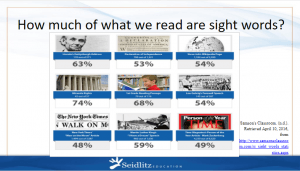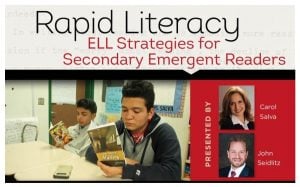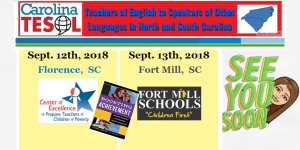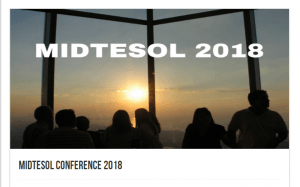So what do we do in the Newcomer classroom after the first days of school?
 Kenzie Twitchell is here to help us work through some standard routines that will have your students speaking, reading, comprehending and writing in English as quickly as possible.
Kenzie Twitchell is here to help us work through some standard routines that will have your students speaking, reading, comprehending and writing in English as quickly as possible.
You can listen to the show on Soundcloud, ITunes or right here:
Listen to “BAP034 Part I of Activities for the Newcomer Classroom with Kenzie Twitchell” on Spreaker.
Kenzie is going to be the person in charge of the ESL program at her campus. She has experience working with language learners in general education classes but this year she will have an entire class of Level 1, Beginners. Kudos to Kenzie for reaching out and trying to find the best practices for her new class!
Kenzie and another new teacher, Brianna Christine both watched a Beginning of the Year video I released on Youtube.
If you are new to teaching emergent English learners, you’ll love that video because it includes the five things I recommend to get your year off to a great start. I highly recommend you watch that video if you have not already seen it.
Both ladies had the same question. “So then what??”
So Kenzie and I set out to discuss what I believe to be the best practices for engaging and inspiring ELs to use the target language while building literacy as well. Of course, you should be following the curriculum for your class. But there are ways to deliver the content that honor what your students bring and align with Balanced Literacy.
For the last several years I have had students with low levels of literacy in their target language. Kenzie also has had some experience with SLIFE (Students with Limited or Interrupted Formal Education). So our discussion was one that takes those students in mind and also differentiates for the learner that has high levels of literacy.
In this show we discuss free voluntary reading (FVR) and how critical it is for our ELs (all students) to read for pleasure and read as much as possible. The issue is that our students may not be able to read independently yet. So we can use Language Experience Approach to help students gain literacy. This approach is a way to engage students in reading and writing in English and offers a great opportunity for oral language practice.
Brianna was somewhat familiar with LEA but had more questions. Here is a video of me doing LEA. This video actually offers a non-example and an example lesson:
 The goals for English Language Development students are
The goals for English Language Development students are
- Get as many sight words as you can
- Get as much phonemic awareness as possible.
The goals for me are to
- Make my content comprehensible (grade level content)
- Develop their academic language
- Support grade level learning with opportunities for higher order thinking.
The text we read together needs to be somewhat comprehensible and we can do that by stopping and negotiating meaning in their native language or using other comprehensible input strategies such as visuals and gestures. In these ways, we can help make text understandable to the student. But we also need them to track the print so that they can start acquiring sight words and phonemic awareness as they acquire more English.
We can do a lot of grade level debriefing with language experience approach. Those shared writing texts should remain available to the students for other purposes.
Above all, the students need to understand that it is critical that they read, read, read. They should understand how many sight words they can gain by tracking print and how much those sight words pay off. To get buy-in from the students, I show them the graphic above from Samson’s Classroom. They need to see how much of the typical text is sight words or little high frequency words. This video shows how my students work together to use our walls to gain English literacy and language. Like all classes, they are awkward at first about working collaboratively, but you can see how engaged and empowered they become.
If they understand the techniques that build literacy… and they are gaining English comprehension every day… they start to be able to read and speak sooner verses later.
We also discuss the value of the following:
Following Twitter hashtags such as #Ellchat, #Ellchat_BkClub and #BoostingAchievement
Following Larry Ferlazzo on Twitter and also subscribing to his blog.
Finding anything that you can on his book, The ELL Teachers Toolbox . Get the book or follow Larry for a ton of free resources. The #ELLTeachersToolbox hashtag is also a great follow.
Follow Valentina Gonzalez, Tan Huynh, Carlota Holder and Emily Francis. They are all masters at sharing research based, best practices for teachers of English learners!
I mention my training with the Gomez & Gomez Dual Language Model
I mentioned Stephen Krashen and this video by Valentina Gonzalez:
After all of this, Kenzie and I KEEP TALKING for another hour! So we have a Part II of this topic coming out tomorrow. In that episode, we talk about where you can take your students now that they are beginning to read and write in English. We want to make the most of our time with the to support content area learning but also continuing to build their literacy and decoding skills.
Stay tuned for Part II!
I hope this has been helpful. Thank you again, McKenzie Twitchell and Brianna Christine.
See you in Part II!
Carol
PS: Please reach out if you’d like to bring Seidlitz Education training to your district. We have thousands of happy teachers who can tell you that our trainings make a huge impact on their practice. I’d love to tell you more about the different offerings. My email is carol.salva@johnseidlitz.com
Also! I’ll be in Houston, South Carolina and Kansas City in the next few months! Hope to see you at one of these functions.
Join us in Houston, Texas on Oct 4th for Rapid Literacy.

Join me in South Carolina on Sept 12 & 13 for Boosting Achievement with Carolina TESOL

Join me at MidTESOL18 on Sept 28 & 29th.
